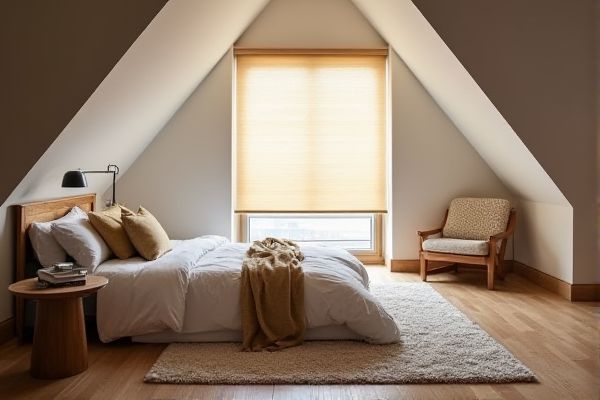
Attic blackout blinds eliminate light effectively, providing complete darkness ideal for bedrooms or media rooms, while thermal blinds prioritize insulation to maintain temperature and reduce energy costs in your home. Discover which option best suits your needs by exploring the detailed comparisons in the rest of the article.
Table of Comparison
| Feature | Attic Blackout Blinds | Thermal Blinds |
|---|---|---|
| Primary Function | Complete light blockage for attic windows | Insulation and temperature regulation |
| Material | Thick, opaque fabric or vinyl | Multi-layered, reflective fabric with insulating foam |
| Energy Efficiency | Moderate - reduces external light and some heat | High - reduces heat loss in winter and heat gain in summer |
| Light Control | 100% blackout | Partial to full light blockage, depending on design |
| Installation | Custom fit for sloped attic windows | Standard or custom, compatible with various window types |
| Cost | Typically lower cost | Generally higher due to insulation features |
| Best Use | Sleeping areas, media rooms in attic spaces | Energy savings and temperature control in all rooms |
Introduction to Attic Blackout and Thermal Blinds
Attic blackout blinds are designed to block nearly 100% of sunlight, providing maximum darkness and privacy ideal for spaces requiring light control, such as bedrooms or media rooms. Thermal blinds, on the other hand, incorporate insulating materials that reduce heat transfer, improving energy efficiency by maintaining indoor temperatures and lowering heating or cooling costs. Both types enhance attic comfort but serve distinct purposes: blackout blinds prioritize light blockage, while thermal blinds focus on temperature regulation.
Key Features of Attic Blackout Blinds
Attic blackout blinds feature high-density fabric designed to block 100% of sunlight, effectively reducing heat and glare in attic spaces. They provide superior insulation with multi-layer materials that help maintain indoor temperatures and enhance energy efficiency. These blinds often include light-trapping side channels to eliminate light leaks, making them ideal for bedrooms and media rooms situated in attics.
Core Benefits of Thermal Blinds
Thermal blinds provide exceptional insulation by trapping air between the window and the blind, reducing heat loss during winter and keeping your attic cooler in summer. These blinds help lower energy bills by enhancing your home's thermal efficiency and minimizing reliance on heating or cooling systems. Your comfort increases as thermal blinds maintain a consistent indoor temperature while also reducing noise pollution.
Light Control: Blackout vs Thermal Blinds
Attic blackout blinds provide superior light control by blocking nearly 100% of sunlight, making them ideal for bedrooms or media rooms where darkness is essential. Thermal blinds, while also reducing light penetration, primarily focus on insulation by trapping heat, offering moderate light reduction without complete blackout. Choosing between the two depends on whether total darkness or energy efficiency through temperature regulation is the priority.
Insulation and Energy Efficiency Comparison
Attic blackout blinds provide excellent light blockage, but thermal blinds outperform them in insulation and energy efficiency by incorporating advanced materials like reflective foils and multi-layered fabrics that reduce heat loss and keep your attic cooler in summer. Thermal blinds help maintain a consistent indoor temperature, leading to lower energy bills and enhanced comfort throughout the year. Choosing thermal blinds for your attic windows optimizes energy savings and improves insulation compared to standard blackout options.
Design Options and Aesthetic Appeal
Attic blackout blinds offer a range of sleek design options that blend seamlessly with modern interiors, providing complete darkness ideal for bedrooms or media rooms. Thermal blinds, while also stylish, emphasize functionality with insulating fabrics available in various textures and colors to enhance energy efficiency without compromising on visual appeal. Your choice depends on whether you prioritize total light blockage or energy-saving aesthetics to complement your attic's decor.
Installation Process and Compatibility for Attics
Attic blackout blinds are specifically designed for angled roof windows, featuring simple, bracket-based installation compatible with various skylight models, ensuring a snug fit that blocks out light effectively. Thermal blinds offer enhanced insulation with multi-layered fabrics, requiring precise fitting often involving tensioned side rails, which may need professional installation to ensure airtight sealing in attics. Your choice depends on ease of installation and compatibility with your attic windows, as blackout blinds cater to straightforward setups while thermal blinds focus on maximizing energy efficiency.
Maintenance and Durability Factors
Attic blackout blinds require regular cleaning to prevent dust buildup and maintain their light-blocking efficiency, while thermal blinds often feature durable fabrics designed to resist fading and wear over time. Thermal blinds provide enhanced insulation benefits with materials that retain their structure under temperature fluctuations, contributing to their long-term durability. Both types benefit from occasional checks on mechanisms like cords and brackets to ensure smooth operation and extend lifespan.
Cost Considerations: Blackout vs Thermal
Attic blackout blinds typically cost less upfront, offering effective light blocking for bedrooms or media rooms. Thermal blinds, while generally more expensive, provide enhanced insulation, reducing energy bills by maintaining indoor temperatures year-round. Your choice depends on prioritizing immediate budget savings with blackout blinds or long-term energy efficiency through thermal blinds.
Choosing the Right Blind for Your Attic Space
Attic blackout blinds provide superior light blockage, ideal for creating complete darkness in rooms used for sleeping or media viewing, while thermal blinds excel in insulation, reducing heat loss and improving energy efficiency. Your choice depends on whether you prioritize darkness or temperature control, with blackout blinds enhancing comfort for rest and thermal blinds offering cost savings on heating and cooling. Selecting the right blind for your attic space ensures optimal functionality tailored to your specific needs.
 homyna.com
homyna.com